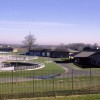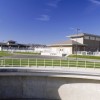Sanitary Utility Sewerage Piping
Video
alt="" SewerPipe InstallSanitary sewer utility piping carries waste water and sewerage from residences, institutions and industries to treatment plants for processing. Sanitary sewer piping should not be confused with storm sewer piping, which is completely different in terms of water source and quality, flow characteristics, and design parameters. Even though closed and buried pipes are used in their construction, sanitary sewers are considered open channel, gravity flow systems. The slope of sanitary sewer piping is designed to provide flows that will prevent any stagnation and settling, but not be so fast as to scour the pipe interiors. This is typically a flow rate of less than 10 feet per second in most applications. Sanitary sewer systems are designed for what is expected to be a theoretical peak flow condition, assuming most system users would apply waste water into the utility at the same time.
Collection lines, also known as laterals, receive waste water from individual buildings and carry it to sub-mains (or branch) lines. Branch lines feed into main (or trunk) sewers that typically carry sewage to a treatment facility. Trunk lines are normally placed along natural features that facilitate gravity flow, such as alongside stream beds. Pipe sizes (diameters) are specified based on the envisioned flow rates within each of these segments. Manholes are placed in these utilities every few hundred feet or so, to allow for inspection and maintenance. Pumps and pressurized-flow piping are only installed in these systems at sewer lift stations or when the natural topography or site constraints limit gravity flow.
This system can be envisioned in the context of an average housing subdivision. Laterals carry waste water from each home to a branch line located underneath or alongside each street. The branch lines feed into a main sewer which runs along any natural low point in the neighborhood topography. If gravity flow from the main sewer cannot reach the closest treatment plant unassisted, a sewer lift station with an array of pumps would be installed, and then gravity flow would resume at the point of lift station discharge.
The materials used in the manufacturing of sanitary sewer piping are concrete, plastics such as polyvinyl chloride, ductile iron, steel, and clay. The pipe materials used in sanitary sewer lines are varied, but they share some common characteristics. In any particular application, sanitary sewer piping must resist leakage, infiltration, scouring, crown corrosion, and crushing under loads. Infiltration refers to the intrusion of groundwater into the pipes, which can add significantly to the flow volume. This may exceed the original design parameters for flow, as well as create increased processing costs at the treatment plant. Leakage of waste water and infiltration can be caused by joint displacement and cracked or broken pipes. Scouring of the pipe interiors could result if the pipes are installed at too steep of an angle, abrasive soils enter into the system, or improper pipe materials are selected. Sewers can build up hydrogen sulfide gas, which combines with water condensate on the interior crown of pipes to form sulfuric acid. This causes corrosion and reduces the structural integrity and service life of the pipe.
These problems can be mitigated by some best practices. Sanitary sewage piping should be placed below the frost line, in a properly excavated and bedded trench, deep enough to be clear of damaging surface loads such as vehicle tires. Proper joint construction and inspection must be assured during pipe placement to reduce opportunities for leakage and infiltration. Regular maintenance and cleaning of sewer lines can reduce opportunities for unmitigated crown corrosion and scouring, as well as quickly detect joint displacements and breakage.

Buildipedia Staff
The Buildipedia research and writing staff consists of dozens of experienced professionals from many sectors of the industry, including architects, designers, contractors, and engineers.
Website: buildipedia.com/




